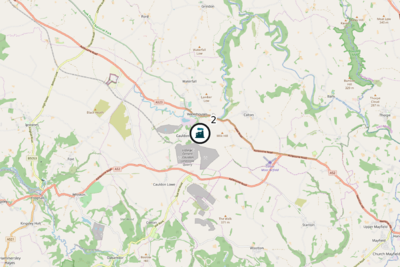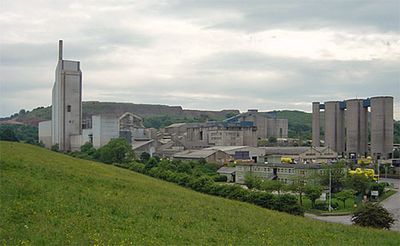Cauldon Cement Kiln: Difference between revisions
Arctellion (talk | contribs) m Arctellion moved page Cauldon to Cauldon Cement Kiln: renamed to reduce confusion with other pages. |
add page specific text |
||
| Line 1: | Line 1: | ||
{{CementKiln|EPR=TP3334AW|id=2}} | {{CementKiln|EPR=TP3334AW|id=2}} | ||
[[Category:Cement Kilns]] | [[Category:Cement Kilns]] | ||
[[File:Cauldon2006 pic.jpg|400px|left|Cauldron Cement Works - source Alan Murray-Rust 2006]]__TOC__ | |||
<br clear='left'/> | |||
==Waste | ==Overview== | ||
WikiWaste has used the website Cement Plants and Kilns in Britain and Ireland<ref>https://www.cementkilns.co.uk/index.html</ref> extensively for the reference material for each individual cement kiln page. The detail on this reference website is extensive and as WikiWaste is focused upon the UK waste and resource market, only the key highlights are captured from this website (and company websites accordingly) to provide background and context. Cauldon started operating in 1957 and up to 2015 had produced 40 million tonnes of clinker through 4 rotary kilns over this period. | |||
==Ownership== | |||
* 1957 to 2001 BPCM (G&T Earles) (Blue Circle) | |||
* 2001 to 2013 Lafarge | |||
* 2013 to 2015 Lafarge Tarmac | |||
* 2015 to Present LafargeHolcim | |||
==The Process at Cauldon== | |||
The following summary diagram is | |||
==Raw Materials== | |||
The primary raw materials are Carboniferous Limestone from Cauldon Low Quarry and Carboniferous Shale in a nearby deposit. | |||
==Waste Used on Site== | |||
The Cauldon site waste return to the [[EA]] for the most recent year of 2018 showed the following wastes used on site, which were used primary for the purpose of substituting fuel requirements in the plant: | |||
{{CKWaste|EPR=TP3334AW}} | {{CKWaste|EPR=TP3334AW}} | ||
The schematic below from | |||
==References== | ==References== | ||
<references /> | <references /> | ||
Revision as of 17:00, 16 April 2020
| Cauldon Cement Kiln | |
 See Cement Kilns → page for a larger UK Wide map. | |
| Waste Licence | TP3334AW |
| Operator | Aggregate Industries t/a Lafarge Cement |
| Parent Company | LafargeHolcim |
| Clinker Capacity | 0.9 Mt |
Summary site information collated from a variety of sources.

Overview
WikiWaste has used the website Cement Plants and Kilns in Britain and Ireland[1] extensively for the reference material for each individual cement kiln page. The detail on this reference website is extensive and as WikiWaste is focused upon the UK waste and resource market, only the key highlights are captured from this website (and company websites accordingly) to provide background and context. Cauldon started operating in 1957 and up to 2015 had produced 40 million tonnes of clinker through 4 rotary kilns over this period.
Ownership
- 1957 to 2001 BPCM (G&T Earles) (Blue Circle)
- 2001 to 2013 Lafarge
- 2013 to 2015 Lafarge Tarmac
- 2015 to Present LafargeHolcim
The Process at Cauldon
The following summary diagram is
Raw Materials
The primary raw materials are Carboniferous Limestone from Cauldon Low Quarry and Carboniferous Shale in a nearby deposit.
Waste Used on Site
The Cauldon site waste return to the EA for the most recent year of 2018 showed the following wastes used on site, which were used primary for the purpose of substituting fuel requirements in the plant:
| Waste Class | Description | Tonnage Input |
|---|---|---|
| 16 01 03 | end-of-life tyres | 25,854 |
| 19 02 08* | liquid combustible wastes containing dangerous substances | 12,020 |
| 19 08 05 | sludges from treatment of urban waste water | 23,062 |
| 19 12 10 | combustible waste (refuse derived fuel) | 327 |
The schematic below from
